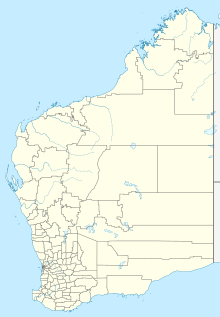RAAF Learmonth
|
RAAF Learmonth Learmonth Airport |
|||||||||||
|---|---|---|---|---|---|---|---|---|---|---|---|
| Summary | |||||||||||
| Airport type | Military/Public | ||||||||||
| Operator | RAAF/Shire of Exmouth | ||||||||||
| Serves | Exmouth, Western Australia | ||||||||||
| Elevation AMSL | 19 ft / 6 m | ||||||||||
| Coordinates | 22°14′09″S 114°05′19″E / 22.23583°S 114.08861°ECoordinates: 22°14′09″S 114°05′19″E / 22.23583°S 114.08861°E | ||||||||||
| Map | |||||||||||
| Location in Western Australia | |||||||||||
| Runways | |||||||||||
|
|||||||||||
| Statistics (2012/13) | |||||||||||
|
|||||||||||
| Passengers | 90,861 |
|---|---|
| Aircraft movements | 1,938 |
RAAF Learmonth, also known as Learmonth Airport (IATA: LEA, ICAO: YPLM), is a joint use Royal Australian Air Force base and civil airport. It is located near the town of Exmouth on the north-west coast of Western Australia. As an RAAF base, Learmonth is one of the RAAF's three "bare bases". No Air Force units are currently based at Learmonth and it is maintained by a small caretaker staff during peacetime.
The RAAF also operates the Learmonth Air Weapons Range which covers about 18,954 ha (46,840 acres) and is located 30 km (19 mi) south-west of the airbase.
During World War II a little-known landing field was constructed on the western shore of Exmouth Gulf. It was code-named "Potshot" and maintained by No. 76 Operational Base Unit. In the 1950s the landing field was further developed as a military base and named RAAF Learmonth in honour of Wing Commander Charles Learmonth DFC and Bar, who, while leading No. 14 Squadron, was killed in a flying accident off Rottnest Island, Western Australia on 6 January 1944.
In the mid-1960s, the Federal Government gave its support to plans by the Chief of the Air Staff, Air Marshal Val Hancock, to redevelop Learmonth as a 'bare base', due to its proximity to Indonesia. Though F-111Cs could have made a round-trip to Indonesia's capital, Jakarta, from RAAF Base Darwin, the route they took would have been very much limited by range. Learmonth's proximity added flexibility to the routes in and out, enhancing the likelihood of a successful strike. The major work was undertaken by No. 5 Airfield Construction Squadron between 1971 and 1973.
...
Wikipedia

